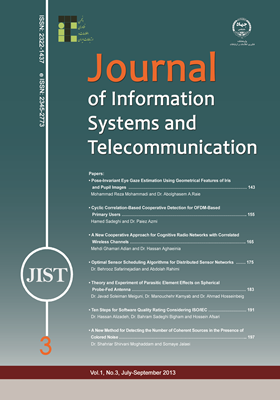-
-
List of Articles
-
Open Access Article
1 - Pose-Invariant Eye Gaze Estimation Using Geometrical Features of Iris and Pupil Images
Mohammad Reza Mohammadi Abolghasem Asadollah Raie -
Open Access Article
2 - Cyclic Correlation-Based Cooperative Detection for OFDM-Based Primary Users
Hamed Sadeghi paeez azmi -
Open Access Article
3 - A New Cooperative Approach for Cognitive Radio Networks with Correlated Wireless Channels
Mehdi Ghamari Adian Hassan Aghaeenia -
Open Access Article
4 - Optimal Sensor Scheduling Algorithms for Distributed Sensor Networks
Behrooz Safarinejadian Abdolah Rahimi -
Open Access Article
5 - Theory and Experiment of Parasitic Element Effects on Spherical Probe-Fed Antenna
Javad Soleiman Meiguni Manouchehr Kamyab Ahmad Hosseinbeig -
Open Access Article
6 - Ten Steps for Software Quality Rating Considering ISO/IEC
Hassan Alizadeh Bahram Sadeghi Bigham Hossein Afsari -
Open Access Article
7 - A New Method for Detecting the Number of Coherent Sources in the Presence of Colored Noise
Shahriar Shirvani Moghaddam Somaye Jalaei
-
The rights to this website are owned by the Raimag Press Management System.
Copyright © 2017-2025







